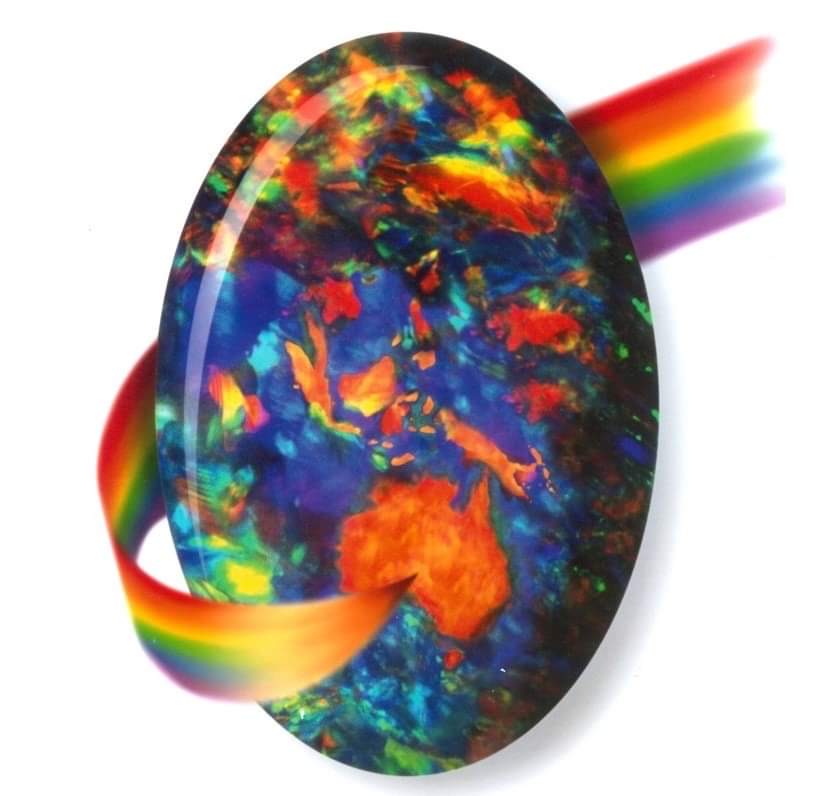About opal
Does someone in your family own a ring or pendant that contains an opal? An opal is a 'gemstone' - that is, a mineral valued for its beauty. Gemstones are most often used in jewellery and examples include diamonds, rubies, emeralds, sapphires, jade, opals and amethysts. Gems generally get their colour because of certain metals contained in the mineral (for example purple amethyst is quartz containing tiny amounts of iron). However opals are unique because they display a rainbow-like display due to their intrinsic microstructure which diffracts white light into all the colours of the spectrum.
Black opal from Lightning Ridge, New South Wales, Smith Collection. Source: Geoscience Australia
Properties
Opals are multi-coloured and consist of small spheres of silica arranged in a regular pattern, with water between the spheres. The spheres diffract white light, breaking it up into the colours of the spectrum. This process is called 'opalescence'. Larger spheres provide all colours, smaller ones only blues and greens. Opals that have a predominantly red colour are very rare as they only occur where larger silica spheres were deposited.
White opals have delicate, pale colours on a lighter background. Black opals (very rare and valuable) have a dark background and colours ranging from brilliant red through to greens, blues and purples. Boulder opals are cut with the natural host rock, ironstone, on the back.
Spheres representing silicon dioxide, stacked on top of each other in layers
Idealized molecular structure of precious opal: an orderly array of silicon
dioxide spheres. Source: Wikimedia Commons
History
Opal artefacts several thousands of years old have been discovered in East Africa. As early as 250 BC the Romans prized opals, thought to have come from mines in Eastern Europe, the ancient world's main source of opals. There are many aboriginal dreamtime stories that feature opal.
Australian opals discovered during the late 1800's found little favour with European markets but their commercial value increased in the 1900's and in 1932 Australia took over as the major producer of opals in the world and remains the largest producer to this day.
In 1915 a group of people were prospecting for gold at the edge of the Great Victoria Desert northwest of Adelaide. Making camp one night, a 14 year old boy found an opal. This started an 'opal rush' and soon the settlement of the Stuart Range Opal Field was founded, better known now as Coober Pedy and together with Lightning Ridge in NSW, the bulk of the world's opal continues to be produced.
Formation
In Australia, precious opal is found in Cretaceous age sandstones and mudstones. These sedimentary rocks were deeply weathered and this weathering released silica into the groundwater. Small faults and joints in the rocks formed pathways for movement of the groundwater as it penetrated downwards.
Impermeable barriers between the sandstone and the underlying rocks trapped the silica-carrying groundwater where it slowly hardened into a gel forming opal in veins and lenses.
Opals are frequently layered and if a rare red layer is present it is at the base in the thinnest portion of the vein and indicates that gravity played a part in the arrangement of the silica spheres.
Australia is the only part of the world where opalised animal and plant fossils have been found. At Lightning Ridge in NSW, small opalised dinosaurs and primitive early mammalian remains, together with shallow marine shellfish and crustaceans have been found. Probably the most famous opalised fossil is Eric the Pliosaur (Cretaceous age marine vertebrate) which was found at Coober Pedy and now forms part of the Australian Museum collection.
Opalised bones of Eric the Pliosaur. Source: stellalapis
Not only is the opalised skeleton of this animal preserved, but also the stomach contents of its last fish meal are replaced with opal. Opalised fish bones and shelly mollusks are also fairly common at Coober Pedy, SA and are valued according to the appearance of the individual specimen and the intensity of the play of colours.
Spectacular mineral replacement with opal can also occur. The so called ‘opal pineapples’ found at White Cliffs, NSW are opal pseudomorphs of the mineral ikaite. Queensland opal deposits occur in non-marine sedimentary rocks and opalised animal remains are very rare, however fossil wood fragments showing annual growth rings and cellular wood textures occur and sometimes these are beautifully replaced with precious opal.
Opal 'pineapple' pseudomorph after ikaite, R30006.
Source: Geoscience Australia.
Page created using Blog & Page Builder by Reputon


